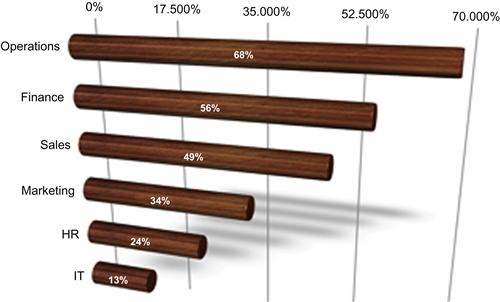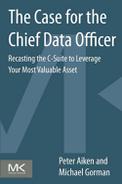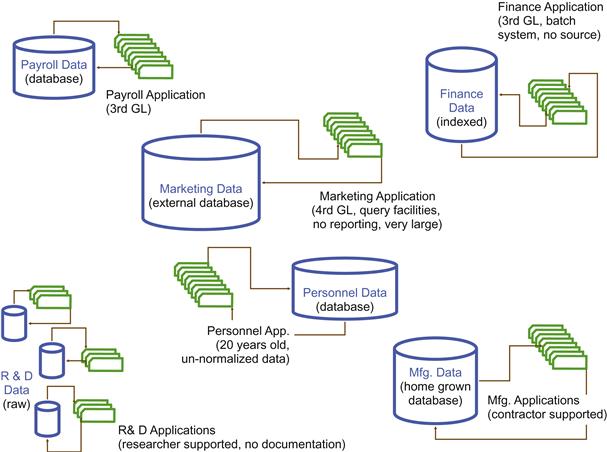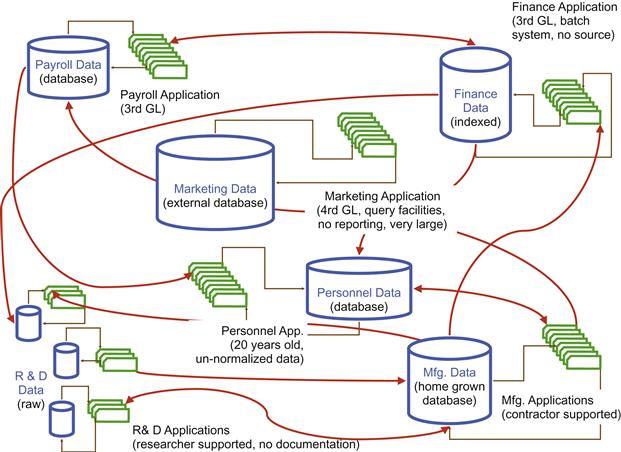Understanding the Current C-level is not Data-Knowledgeable
2.4 The Broad Technology Focus of Most CIOs
2.5 CIO Preparation – Agreeing on Uniform Qualifications
2.6 What are the CIO DATA Function Challenges as Currently Practiced?
2.1 Chapter Overview
We describe the reasons that C-level executives are not data-knowledgeable. To understand the challenge, it is important to understand leadership and symbolism requirements accruing to chief officer positions, as well as a needed technology management focus, and highlight the varied backgrounds brought to IT chiefs.
2.2 Who is Your Data Chief?
If you picked up this book and thought to yourself:
Hmm – isn’t the CIO the top data job?
Then you are exactly the person we are trying to reach. The short answer is:
Not in today’s IT!
Before launching into what some have already viewed as a critique of the CIO function, it is important we state that CIOs have accomplished astounding feats, developed excellent organizational skill sets, and delivered tangible business value. In the process, we’ve learned a great deal about using technology to obtain a strategic advantage.1 CIOs have our tremendous respect for the amazing results delivered by the organizations they oversee, the differing approaches to IT management, and reward systems (Wailgum 2009).
As a group, they have proven themselves astoundingly capable and quite adept at addressing organizational challenges – often by incorporating new technologies (clouds, analytics, service architectures, etc.) into complex environments. With rapid technology advancement, slow learners quickly fall behind and those who survive as successful CIOs have achieved extraordinary successes. But those who are successful are still largely not data-knowledgeable of the foundational role data plays in IT. Most organizations suffer from poor DM and a small but measureable number (less than 10%) think the approach we have outlined below is just common sense. An early reviewer of this book stated:
I have worked with very senior, very talented CIOs. These folks fundamentally understand data – the complexity, multi-dimensional behavior and systemic flow of data. They understand the consequences of not delivering data to key operations. They understand the importance of data around operational risk and risk reporting. So it’s not a knowledge issue – I believe it’s a focus and attention issue.
We have to respectfully disagree with the reviewer.2 Our combined 80+year experiences3 with more than 500 organizational DM practices indicate that 90(+) percent of CIOs are not data-knowledgeable. The data-knowledgeable 10% are inevitably surprised to learn they comprise such a small minority. As a group, CIOs have not managed to:
Manage data as an organizational asset in an attempt to obtain a strategic data advantage!
Data are an organization’s sole non-depletable, non-degrading, durable, strategic asset. You can’t use it up. If properly maintained, it cannot degrade over time or from use. It is by accounting definitions, durable – persisting beyond the one-year yardstick. Data’s value increases as it evolves along the value chain. From business predications, it becomes transactions, and ultimately returns full cycle – the basis for future predications. So far we have failed to acknowledge data’s primary potential value – factual information, fit for use, describing the organization’s operations/environment and improving decision-making. When combined, these make data unique as assets in the organizational repertoire.
Data are assets that deserve to be managed as professionally and aggressively as other company assets. Objective measurements show that few organizations achieve DM success and are able to exploit a strategic data advantage (see Chapter 3, Section 3.4). In the face of the ongoing ‘data explosion,’ this leaves most organizations unprepared to leverage their data assets.
Returning to our title …
If the CIO isn’t the top organizational data job then what is?
The answer is that much of the care and feeding of data assets occurs at the technical level – if at all. CIOs/IT leaders and knowledge workers in general have little education/training in, and thus do not possess, the requisite KSAs to make decisions about organizational data. Being not data-knowledgeable, collectively, they don’t know what they don’t know. What knowledge they have has been acquired on the job and, because data can occupy only a fraction of their focus, not much OJT has taken place.4
2.3 Chief Officers
The definition for chief is: “the head or leader of an organized body of people; the person highest in authority: the chief of police. dictionary.com
Organizations have recognized the need for individuals to be knowledgeable and accountable for important organizational assets and functions. Figure 2.1 is a (Wikipedia) list of 58 commonly used organizational titles beginning with the word ‘chief.’
The organizational expectation5 is that the individual holding the title is the most knowledgeable executive in the organization and is responsible for the organizational asset referenced by their title. The Chief Financial Officer (CFO) is the individual possessing the KSAs to be both the final authority and decision-maker in organizational financial matters. The Chief Risk Officer (CRO) is the individual possessing the KSAs makes decisions and implements risk management. The Chief Medical Officer (CMO) is responsible for organizational medical matters. (The list continues … ) The organization, and the public, has similar expectations for any of chief officer.
2.4 The Broad Technology Focus of Most CIOs
The first uses for computing technology were to automate existing manual processing – making existing processes faster. As well articulated:
Fifty years ago, data management was simple. Data processing meant running millions of punched cards through banks of sorting, collating and tabulating machines, with the results being printed on paper or punched onto still more cards. And data management meant physically storing and hauling around all those punched cards (Hayes 2002).
Tasks such as check signing, calculating, and machine control were implemented to provide support for departmental-based processing. Early on, there was no industry-wide approach to data processing systems development. The systems were the product of the creative minds and spirited individuals within departments (i.e. Personnel, Payroll, Inventory, Manufacturing, etc.). Each functional unit of the organization developed its own, siloed, data processing systems and data (see Figure 2.2).
These siloed systems worked well in isolation but requests for integrated data require significant additional development to accomplish the integration and large quantities of additional processing to achieve it. The description of the upward theoretical complexity required to integrate N siloed systems is:
![]()
Figure 2.3 graphs this function to illustrate the steep rate of increase in the quantity of integration-only based systems that need to be created. (In some environments, ETL comprise much of this class of systems.) To completely integrate the six systems shown in Figure 2.2, 15 different data interface systems need to be created to connect everything to everything using point-to-point interface solutions.6 The red X on Figure 2.3 signifies the complexity point a large bank calculated as it managed 5,000 interfaces among 200 major function-based siloes. These numbers and complexity levels pervade all types of organizations and have held steady across decades – in spite of the advent of the ERP, SAAS, SOA, cloud, MDM or any other technology-based buzzword.
Each data interface becomes a data processing system in its own right (ETL, for example, comprises a major category of small systems). If you start with six silo-based systems, and add the 15 data interface systems, you end up with 22 systems required to provide point-to-point connections among six siloes.
As you can see from Figure 2.4 more than a few interfaces and the costs of point-to-point connectivity among siloes far outweigh their primary advantage – the solution implementation speed. When managing too much complexity, an organization’s IT (and general) productivity decelerates. The more programmatically data interfaces can be managed, the lower IT’s costs become.
Eventually, these arrangements required an individual-in-charge – a position that has evolved into the ‘Chief Information Officer,’ who is seen as responsible for all things technology. Wikipedia as defines a CIO as:
• The chief information officer (CIO), or information technology (IT) director, is a job title commonly given to the most senior executive in an organization responsible for the information technology and computer systems that support organization goals (Wikipedia 2012).
According to another definition, the CIO, is:
• The executive officer in charge of information processing in an organization. All systems design, development and datacenter operations fall under CIO jurisdiction (Encyclopedia 2013).
This makes both makes intuitive sense and also simultaneously accounts for much of the misconception. If CIOs manage the information technology, then is seems natural that they must also manage the information. Analysis (see Chapter 4, Section 4.4) shows this not to be true. Complicating further, is a lack of uniform CIO qualifications/preparation.
2.5 CIO Preparation – Agreeing on Uniform Qualifications
There is a general belief that the average CIO tenure is from 18 months to two years (Marks 2011). A search for ‘CIO tenure’ reveals a more diffuse picture. Recently, unsubstantiatable evidence has been introduced indicating that CIO tenure is approaching 4.5 years. In contrast, the information that the tenure of CFOs appears to have increased to almost 12 years in the year 2010 is easily obtained form the web (WEBCPA 2010). Some of this stability can be explained by a singular task focus.
CFOs have uniform prerequisite skills, certifications, and educational accomplishments. Professional organizations and recognized best practices uniformly dictate non-controversial KSAs. The Chief Financial Officer (CFO) commonly possesses a Certified Public Accountant (CPA), a Masters degree in Accounting, a Certified Management Accountant (CMA), an MBA, other recognized degrees/certifications, or at least a strong accounting background (Congress 2002). These are, widely recognized as necessary but insufficient prerequisites/qualifications and, applauded.
CIO backgrounds have much variety. A strong IT knowledge has been seen to be a big “plus” – with the other “plus” being organizational experience. While the lack of a “Qualifications Section” in Wikipedia is hardly proof, there is very little agreement on what is an appropriate background for a CIO. Popular CIO backgrounds include operations, finance, and sales/marketing (see Figure 2.5). Wikipedika continues, “recently CIOs’ leadership capabilities, business acumen and strategic perspectives have taken precedence over technical skills. It is now quite common for CIOs to be appointed from the business side of the organization, especially if they have project management skills” (Wikipedia 2012).

Figure 2.5 CIOs varying backgrounds. (from McCafferty 2011)
CIOs come from a variety of backgrounds and are expected to master a wide variety of technologies as well as oversea a variety of technical functions. Despite a lack of formal, comprehensive, certifications and educational accomplishments, the CIO is the business executive upon whom is placed the requirement for the broadest skill set! These required skills include (from Curran 2009):
• Hands-on technology background;
• Experience in leading large change programs;
• Experience in running successful IT infrastructure operations;
• Management experience in a non-IT function;
• Innovative thinking that can solve relevant industry and business issues; and
• The ability to understand how projects and operations impact corporate financials.
Finding these in a single individual has been a challenge. A quote well describing the current situation comes from a former CIO colleague:
Advisors have been pontificating on the evolution of the CIO role towards CPO – Chief Process Officer. So now the CIO would own all technology, all processes and all data. No other organization is experiencing this evolution into other spheres of influence. The CHRO does HR work. The CFO does financial work. The COO does operations work. However, the CIO is expected to be the head of technology, the architect of all business processes and the intelligence behind leveraging data.
Most CIOs today are challenged with being ‘experts’ on technology (infrastructure and application), business process, relationship management and data management).
None are successful at all and most have a bent towards only one of those areas, depending upon where they began their career and the path they took to attain their CIO role (Giuffrida 2011).
The management of data as an asset has almost never been seen as a significant CIO skill or job qualification requirement. Outside of previously referenced specialty programs, there are not many places that an aspiring IT executive would even encounter DM as topic of study. Smart, anxious-to-learn individuals, study, preparing for IT leadership – primarily through graduate curricula. They take classes and learn what we teach them.
A typical computer science/information/systems/ computer engineering degree includes just one course focusing on data. That course typically focuses on the how of building a database using Oracle, MS-Access/SQL Server, or an open source project.7 A typical business graduate might be exposed to Microsoft’s Access. Because DM is not a formal part of the curricula, they explicitly learn that DM is not part of what IT leaders do. As DM was not part of their education, it doesn’t become part of their IT management purview. This technology focus provides the average IT worker with very little practical knowledge of how to best leverage data assets. As a result, very few IT or business professionals are data-knowledgeable.
In summary, while some C-level positions benefit from uniformly mandated knowledge, skills and abilities, the CIO function is lacking these consistent qualifications. Consistently, the CIO function has been not data-knowledgeable – there has been a lack of explicit, reliable and repeatable knowledge of how to leverage data assets. Because of the long-term planning required to obtain significant ROI, this results in IT leadership not considering various planning tradeoffs and making poor data decisions.
2.6 What are the CIO DATA Function Challenges as Currently Practiced?
Because IT is complicated, organizations often find it more effective to concentrate technical skills in fewer specialists instead of teaching all knowledge workers to (for example) manage servers. IT attempts to create IT-leverage, using a few knowledgeable specialists that provide services to all. However, unlike most Chief Officers, who have real authority over their function area, e.g. CFO has real authority over finances, CIOs are generally:
• Not the ultimate authority on informational assets;
• Not able to devote the required time/attention to manage these assets;
• Not possessed of the requisite expertise to make good data decisions; and
• Not situated to achieve organizational data success from their technology/application-centric perspective.
Using the above criteria, few current CIOs qualify as data-knowledgeable.8 Being not data-knowledgeable and using the title, these CIOs are unintentionally misleading their organization in two ways:
1. They are misleading them into thinking the CIO has focused requisite attention on leveraging the organization’s data assets; and
2. That the CIO has the requisite KSAs and is capable of making good data decisions.
Our educational and professional support systems have left this 90% CIO group – not data-knowledgeable.9 Section 4.4 in Chapter 4 shows that the CIO agenda is so overwhelmed that to divert resources to data management would literally force something else to be dropped – an impossibility for most. Only a fraction of these busy executives have reallocated options that don’t hurt other responsibilities. This serious structural gap exists in most organizations and is a root-cause of many IT challenges.
2.7 Chapter Summary
We presented the ‘Chief Officer’ function and the surrounding expectations, background, and preparations. We explained why today’s CIO is unlikely to be data-knowledgeable due to the lack of organizational DM visibility in educational/professional curricula. This has led to other problems impacting organizational IT success. We must remove the pressure on whoever serves as the technology Chief by creating a data Chief.
1Unfortunately, from a learning/improvement perspective, it has been difficult to extrapolate lessons from their successes beyond case studies and surveys. Noted research (see Huff 2009 – two citations) has relied upon vagaries such as “the existence of a system” to assume capabilities, an unwise assumption given what we know of data quality (see also English 2009).
2Our guess would be that the nature of the reviewer’s job attracted top-caliber colleagues.
3As of publication, 2013 Aiken has 30 years in the business, Gorman 50.
4Perhaps not surprisingly, knowledge workers tend to be more data knowledgeable – perhaps given that they work with it more consistently.
5For the finance domain, this is a mandate – the U Sarbanes–Oxley Act of 2002, enacted in the aftermath accounting scandals, requires at least one member of a public company’s audit committee to have financial expertise (Congress 2002).
6Six sources, if you count R&D as one big system. For that to occur the same integration must be accomplished within R&D. If not, then n rises to 8 – now requiring 28 interfaces for maximum connectivity!
7Because a very small percentage of data management time is devoted to building new databases, one could make a very strong case for evolving the content of the “data course” to something more useful for future IT professionals.
8In many instances, addressing this challenge is as simple as reading the DM BoK!
9We did not use the term “data-literate” as this is a much lower standard.




